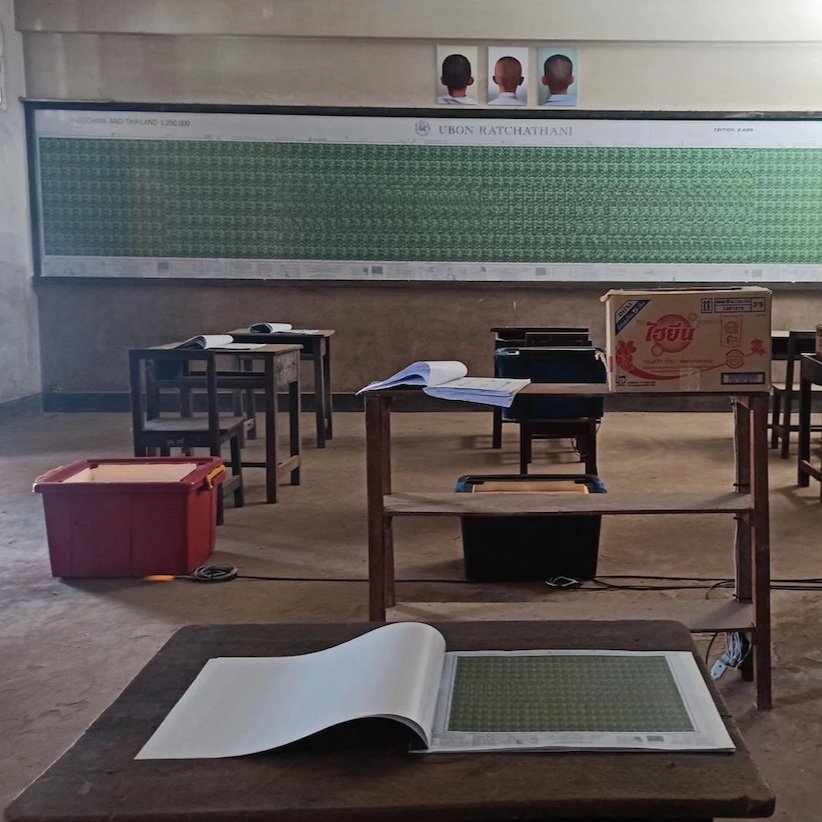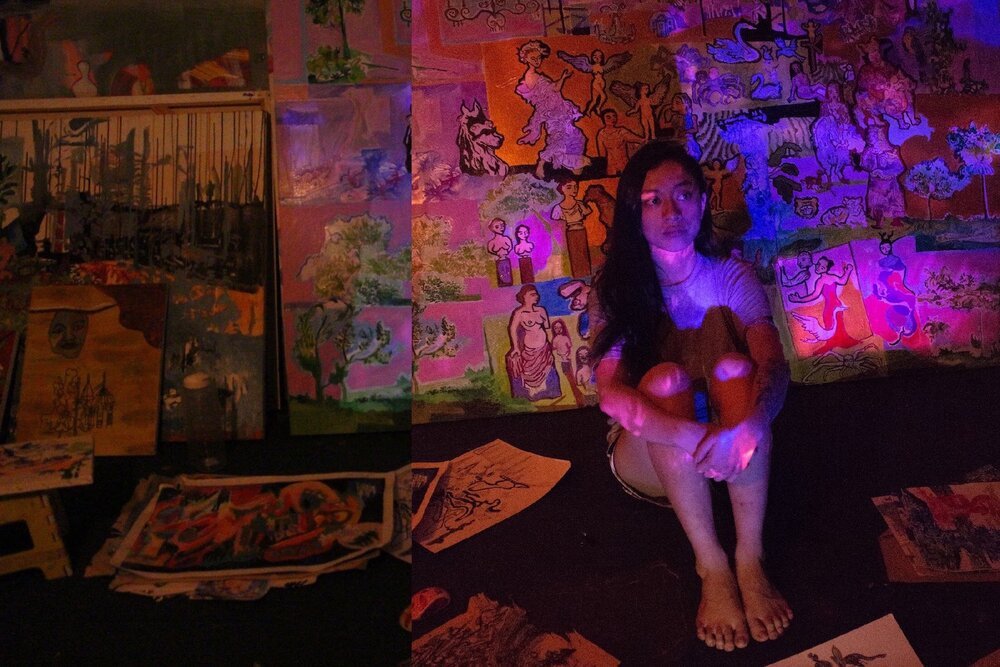Conversation with Laotian artist Souliya Phoumivong
Animator, educator and founder of Clay House Studio
By Ian Tee
Souliya Phoumivong.
Initially trained as a painter, Laotian artist Souliya Phoumivong is best known today for his video works which combine filmed footage, stop-motion animation and handmade clay models. In 2012, he established Clay House Studio, the first production facility in Laos focusing on video and stop-motion works. On top of providing mentorship to younger artists at the studio, Souliya is also a lecturer at the National Institute of Fine Art in Vientiane. His work has been included in the Asia Pacific Triennial 9 (2018), 'Missing Links' at the Jim Thompson Art Centre, Bangkok (2015), and 'Cross+Scape' at the Kumho Museum of Art, Seoul (2011).
In this conversation, Souliya shares his experiences as an artist and educator, as well as his observations on Laotian contemporary art.
Clay House Studio. Image courtesy of Souliya Phoumivong.
You graduated in 2008 with a Bachelor of Arts from the National Institute of Fine Arts (NIFA), Vientiane. Could you describe the education system and your experience in art school?
I was trained in painting at NIFA and was taught Lao art history. However nowadays, the curriculum includes world art history too. After graduation, most of my classmates found salaried jobs with the government office, private companies or opened their own art business. Only a few of them became "signature" artists who create unique works based on their own identity and ideas.
In that same year, you joined some other NIFA graduates to open 5 Arts, the first artist space and commercial gallery in Laos that was run entirely by locals. Prior to that you were already selling your paintings to tourists by the Mekong River in Vientiane. Who were the other co-founders? And what was the audience like for 5 Arts?
I started 5 Arts together with Bounpaul Phothyzan, Nivong Sengsakoun, Amphonesouk Phausoulin and Vankham. With the exception of Bounpual, the other co-founders were working government jobs and making art on the side. At that time, we ran this business by ourselves without any experience of organising exhibitions. 5 Arts was just a space to show and sell our paintings. About 70% of visitors were foreigners and tourists. We closed 5 Arts in 2011 as there were fewer customers after the economic crisis and rental for the space increased.
Souliya Phoumivong. 'Big World' (video still), 2010, stop-motion animation. Image courtesy of the artist.
You created your first Claymation work 'Big World' in 2010 during a residency at Youkobo Art Space, Tokyo, administered by the Japan Foundation. Could you talk about your experience during this residency? And what drew you to this medium?
That residency was my first time outside of Laos and I wanted to challenge myself. In my mind, Japan is the land of animation; and as a teacher, I wanted to bring new knowledge back to Laos and pass it on to young students at home. However, I didn't know anything about computer graphics then so it limited my access to animation. Stop-motion was the only technique I could execute, working with clay and using simple addictive and subtractive sculpture skills. My first Claymation work 'Big World' features me and a buffalo exploring Tokyo, seeing and learning about Japan. I photographed the clay models in the streets and made the video by piecing these shots into a narrative.
Clay House Studio, 'My Village' (video still), 2012-2017, stop-motion animation television series. Image courtesy of Souliya Phoumivong.
One major project Clay House Studio produced is 'My Village' (2012-17), the first clay animation TV show in Laos. Some of these edutainment programmes for Lao children were initiatives by United Nations entities such as UNICEF. Was the studio sustained only on income from these commissions? And how did these productions affect your art practice?
Yes, the studio was mainly focused on producing this series. 'My Village' was a big five-year project so I had to train some of my students to help me with it. Actually, there were other jobs that interested me, but due to limited time and manpower in the studio, we couldn't accept additional work until this project was finished. When 'My Village' came to an end, I made a small animation 'Nang noi' for UNFPA and a new animation TV series called “Learn Together” for the Ministry of Education and Sports, which is supported by the Australian government.
These long projects gave me less time to think about my own art practice, though I still managed to finish a few works. I became known to the public as an artist who made educational videos for children in Laos. Many of them and their parents are big fans who asked for studio visits. However, in art circles, people still only know me as "Mr. Buffalo".
Clay House Studio, 'Learning Together' (video still), 2016-2020, stop-motion animation television series. Image courtesy of Souliya Phoumivong.
Behind the scenes at Clay House Studio. Image courtesy of Souliya Phoumivong.
How many people are there working in Clay House Studio now? I've read on your Instagram page that there are plans to open a gallery in the compound.
There are 5 main members working with Clay House Studio now, but the number of people changes every year. I see the studio as a space for everyone, especially young people who want to gain experience in this field. They can come here to work and experiment with their own ideas. In the near future, I am going to make this space into a small museum to show my past Claymation works. Many people remarked that this is the one of the first places in Laos where one can study animation.
Souliya Phoumivong, 'Flow' (video still), 2018, stop-motion animation, sound. Image courtesy of the artist.
You are one of three Laotian artists included in the Asia Pacific Triennial 9 (APT9), together with Bounpau Phothyzan and Tcheu Siong. Could you talk about your work 'Flow' (2018) and the decision to present it as an installation?
'Flow' is a reflection of contemporary society not just in Laos but around the world, in which most people choose to forget their own identity and follow the herd. Mainstream society tells us that we should pursue material excess and keep up with the fast-moving modern world. People who think and act differently are viewed as strange, and feel pressured to conform.
I wanted the audience to see the clay figures used to create the animation, and so I decided to present them together with the video. By allowing viewers to walk around and see the objects from different perspectives, I think it also adds different meanings and emotions to the narrative.
Exhibition of works by students at National Institute of Fine Arts, Vientiane. Image courtesy of Souliya Phoumivong.
Currently, you are also teaching at NIFA. What are your observations on the new generation of artists coming out of the institute? How has the school and Laotian society's outlook on contemporary art changed since your days as a student in the early 2000s?
Students in most arts institutions create art for sale and that means following the client's orders and preferences. It has been said that no graduate student has created a unique piece of art for exhibition since 2011. We are trying to develop the arts community. However, this is not easy because most people are more concerned about making a living and there is little financial security in creating contemporary art. Lao people in general don't understand what contemporary art is. They are used to landscape painting and traditional art, and most do not go to exhibitions.
Do you have upcoming exhibitions or projects that our readers can look forward to?
I am currently preparing a video installation which will be shown at the Bangkok Biennale. I also received an invitation to show 'Flow' in Indonesia.















